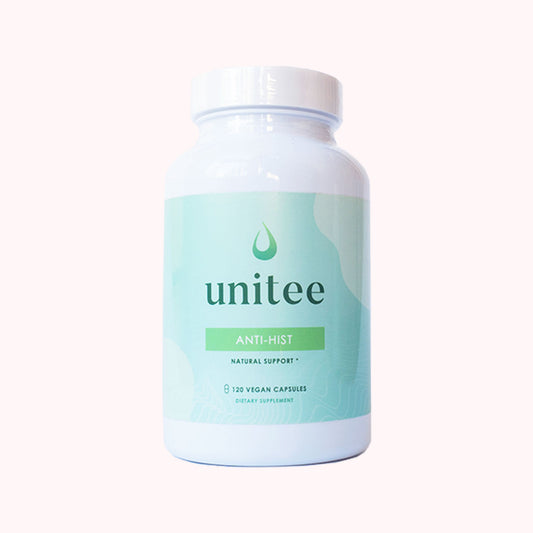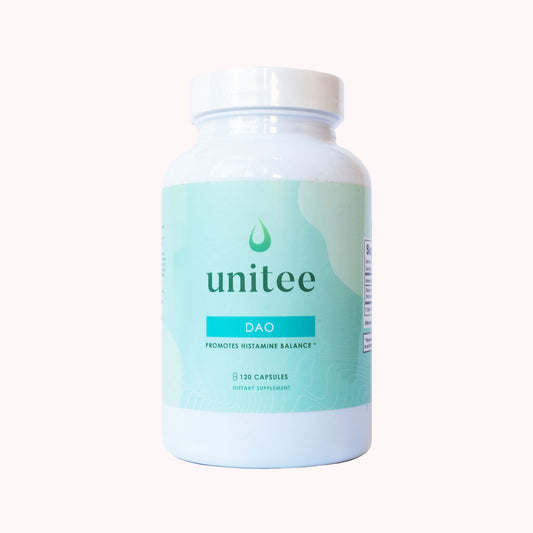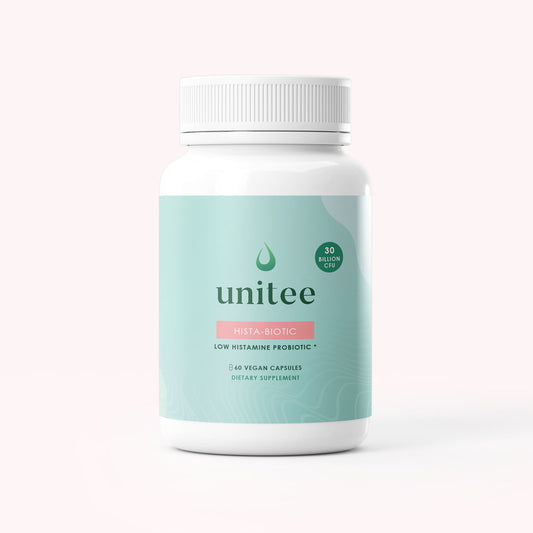Feeding toddlers can be a challenging task. Between dealing with their varying appetite, short attention span and picky eating habits, a parent has their work cut out for them.
This task can become even more challenging when food appears to induce unpleasant symptoms for the child, such as recurrent stomach aches with or without accompanying diarrhea, itching body, hives or even something as seemingly simple as constant congestion or a runny nose and sneezing.
In addition to making mealtimes and meal prep a dreaded experience for the caregiver, these symptoms could affect the child’s pleasure around eating, their overall nutritional intake to the extent of affecting their growth and development, affecting their long term eating habits and preferences, as well as affecting the whole family’s ability to socialise (1).
At this point - the dreaded question hits: what the heck is going on inside my child!?
Is Food Making My Child Sick: Allergies or Intolerance?
The symptoms mentioned above may very easily be attributed to food allergies; and, often are. But, they may not actually arise from food allergies in the true sense of the term. Several studies have demonstrated these reactions can also be non-immunologic. When allergy tests were performed in the participants of the study, all experiencing a wide range of these symptoms, the results showed that not all of them were related to true allergic responses (2)(3).
What do I mean by a true allergic response?
Well, there's a big difference when it comes to allergies and intolerances (4). A true allergy is a hypersensitivity reaction that occurs in the body, causing the immune system to believe that there is a foreign invader that needs to be neutralized. Symptoms often resemble an intolerance, but can be far more severe, and even life threatening. True allergies can cause trouble within seconds of coming into contact with the offending compound, and may cause the mouth and throat to swell, which is where the life-threatening events come into play.
Intolerances may not be as alarming, but should never be dismissed as being arbitrary. They too can cause many bothersome symptoms, and even if they aren't life threatening, continuing to be forced with these symptoms can seriously diminish one's quality of life and have a significant impact on one's overall health.
Additionally, while food allergies will typically present soon after the culprit food has been eaten, symptoms caused by non-allergic reactions may appear hours (even days) after the food is eaten. In this case it can either be as a result of the child being directly exposed to the compound, or even through indirect exposure from the mother in the case of breastfed infants.
This delayed reaction time can enhance confusion, as exposure to the culprit food item may not always appear to elicit symptoms right away. Symptoms may appear to be precipitated by some unrelated food, exercise or even seasonal changes. Or, the child may even appear to react to any or all foods they've eaten. Pre-existing conditions such as eczema or behavioural problems may even appear to get worse with certain foods. This can be quite frustrating and leave the caregiver feeling hopeless regarding their approach to their child's wellbeing.
Often, in such complex cases, medications such as antihistamines will be tried, but they can have unpredictable outcomes.
Histamine Intolerance in Children and Babies
While stomach aches may be an indication of many different conditions of childhood and is perhaps the easiest symptom for children to express, it also happens to be one of the first symptoms of histamine intolerance (5).
When it becomes a recurrent complaint, accompanied by other symptoms such as an itchy body or tongue after eating certain foods, frequent episodes of congestion and hives, skin conditions such as eczema or psoriasis, or restlessness and colic in the younger child, a parent may consider histamine intolerance as a potential cause of these symptoms.
The reason a stomach ache is so common in histamine intolerance is because of what histamine does to the body. Once it has been released by the mast cells that line the tissues in the digestive tract, histamine increases the firing rate of the receptors responsible for the sensation of pain. Essentially, this pain is a warning to the body that something is wrong. When histamine sensitizes these pain receptors located in the digestive tract, it can lead to stomach or gut ache (6). And when there's too much histamine, which is an issue for those with histamine intolerance, gut ache can be a frequent and ongoing complaint.
To recap, histamine intolerance occurs in susceptible individuals when the levels of histamine degradation cannot keep up with the levels of histamine accumulation. Basically, there is too much histamine in the body, either from being consumed from food, or produced internally by the body without the necessary resources for the body to break histamine down. There are four common causes, which you can read about here.
The histamine molecules, whose role in the body is to alert the immune system to the presence of allergens, is now triggering that alert more often, which leads to an exaggerated pseudo-allergic response.
In this case, even though the symptoms appear to be those of an allergic reaction, there may be no actual allergen triggering the response. Rather, it's the abundance of the molecule histamine that the susceptible individual has failed to break down and eliminate from the body that keeps this body responding in the way it does.
Why is Histamine Hanging Around?
While you now know that histamine intolerance is an issue with high histamine levels, histamine will always be present in the body. Each day, histamine is produced, released and taken in constantly. Whether it's through bacterial production or eating high histamine foods, raising the levels of internal histamine is a common daily process.
In a normally functioning body, however, histamine is then broken down by the enzyme Diamine Oxidase (DAO). This process prevents histamine from accumulating in the blood and normalizes internal histamine levels (6).
If levels of histamine begin to creep up, that's when symptoms begin to appear. Think about a bucket or container for a minute. Imagine filling it half way with water. Now, throughout the day, remove some water here and there, and then add some back here and there. At the end of the day, that amount of water won't have changed much. Imagine now that you can't remove any water, but you still continue to add. What happens? That water can fill the bucket and begin to spill out over the edges, leaving quite a mess!
That's exactly what happens with histamine intolerance. The bucket is overflowing, and the mess it leaves behind are the symptoms one experiences.
The symptoms most relevant to children include; gastrointestinal (stomach aches, bloating, diarrhoea), skin (flushing, itching, hives, eczema, psoriasis), nervous system (headaches, mind fog), cardiovascular (increased heartbeat) and, respiratory (sneezing, congestion, breathlessness with exercise) (7,8).
Additionally, histamine levels can continue to increase steadily, causing progressively worsening symptoms (imagine more and more water damage begin caused by the bucket overflowing).
And you'll be able to pick this up in your child. For example, a child who has previously only complained of mild stomach aches may now start to have more severe episodes and experience diarrhoea and weight loss. And unless a solution is instituted, may continue to acquire newer and more distressing symptoms.
Why Isn't Histamine Breaking Down?
There are many underlying reasons that can cause or contribute to becoming histamine intolerant. Reasons specific to DAO issues range from reduced DAO production due to genetic inheritance (9), inhibition of DAO through the consumption of certain chemicals, drugs or additives (10), nutritional deficiencies such as copper, zinc, Vitamin B6, and Vitamin C which support DAO functioning (8).
Another enzyme Histamine N-methyltransferase(HNMT), is also involved in the breakdown of histamine and its dysfunction may also contribute to an accumulation of excess histamine, but it appears to play a minor role in histamine intolerance in comparison to diamine oxidase (11).
In fact, the influence of DAO is so powerful that it can even be measured as one of the main diagnostic indicators of histamine intolerance (7,12). Studies have shown levels of DAO below 10 U/ml to be associated with histamine intolerance in both adults and children (5), while symptomatic individuals with levels above these were unlikely to be histamine intolerant (13,14). For adults, taking an all-natural DAO supplement can be one of the best ways to increase DAO levels and, therefore, improve histamine intolerance symptoms. Unfortunately, no such studies of DAO use in children have been done to date.
For more comprehensive details and additional reasons that could cause histamine intolerance, have a look at my post on what causes histamine intolerance.
How Much Histamine is Too Much?
As mentioned earlier, histamine is essential to us because it acts as a warning signal when potentially harmful foreign molecules enter the body. Histamine is therefore widely distributed throughout the body, which is why histamine excess symptoms can impact different body systems.
Normal histamine levels range from 0,3 to 1,0 ng/ml. Above this level, symptoms begin to appear and can even progress to cardiac arrest above 100 ng/ml. Levels between 1 – 3 ng/ml may cause itching, hives, rapid heart rate and flushing. Additionally, these levels can increase the secretion of stomach fluids and the contraction of stomach muscles, which the child will experience as stomach cramps and diarrhea (3,10).
Excess histamine can come about because of increased release from mast cells following stimulation, such as, during a particularly bad hay fever season, for example. In children with compromised DAO functioning, the body will struggle to bring down the histamine levels accordingly, which creates a cumulative increase in the circulating levels of histamine. Eventually, a tipping point is reached where the body’s histamine tolerance is exceeded - again, think about the bucket overflowing with water and causing damage to its surroundings.
The consumption of histamine containing foods and histamine releasing foods adds to the demand for DAO and will precipitate the symptoms of excess histamine. Histamine is present in many foods - and, it's completely natural and is contained in even extremely healthy foods. This is why, even if you're aiming to provide your child with a healthy, all-natural diet, symptoms may still continue to appear, despite your best efforts!
If you're looking for a comprehensive list of low and high histamine foods that details exactly what you can and cannot eat, download the histamine intolerance food list which, for histamine intolerant individuals, will start relieving symptoms in as little as 1-2 weeks (7,9,12).
Important: it's notable that this list would apply to both children and adults - and, for a breastfeeding mother, high histamine foods should also be reduced to avoid transferring excess histamine to your child through milk.
Diagnostics & Therapies for Histamine Intolerance in Children and Babies
Histamine intolerance is still an obscure subject in both medical and nutrition circles, therefore one may need to patiently search for a qualified professional who is aware of the condition, able to appropriately recognize it and, guide its management.
One standard diagnostic scale requires 2 or more digestive symptoms (e.g. diarrhea, stomach ache or bloating) experienced for more than 3 months, a DAO level below 10 U/ml, a positive response to a low histamine diet, and negative IgE (allergy) test results, to make a diagnosis (6). Since histamine intolerance is so diverse, these measurements are not exclusively necessary, but, most studies agree that clinical history and a positive response to a low histamine diet are some of the most reliable diagnostic qualifications (3,10).
I created an at-home version of a histamine intolerance test, in order to better understand responses to a low histamine diet and a reduction in histamine load. Read my post on this at-home test.
It's notable that this test was created for adults and requires the use of a histamine-lowering supplement called Anti-Hist, which is a natural antihistamine used for adults. This supplement should be omitted when considering applying testing measures to children.
Histamine Intolerance Food Elimination and Reintroduction
If you suspect that your child may have histamine intolerance, it is ideal that you seek the advice of a healthcare practitioner to guide you through your journey. Seeking help is essential because histamine intolerance may mimic other conditions, such as IgE food allergies, which can be life threatening and would not respond to a low histamine diet.
Contact with a professional also allows for underlying conditions to be identified and appropriately managed or eliminated, such as gut permeability, bacterial dysbiosis or chronic inflammatory bowel disease (3), which can precipitate histamine intolerance by allowing histamine and its metabolites to enter the bloodstream through a disrupted gut wall.
The gold standard for management of HIT is the implementation of the low histamine diet, in which histamine containing, and histamine releasing foods (detailed in my histamine intolerance food list) are removed from the diet, with symptom reduction commonly occurring within 1-2 weeks, or up to 4 weeks in more severe cases (12,15). The diet is necessary for both the child and the mother if the mother is breastfeeding.
What's Next in Your Child's Histamine Intolerance Journey?
As explained above, HIT symptoms arise from histamine levels increasing cumulatively over time until a tipping point is reached. The low histamine diet allows the histamine breakdown mechanisms to recover and gradually reduce these levels to below tipping point.
Once symptoms have resolved and the child is stabilised, it is possible to begin to reintroduce the foods one at a time, in graded amounts, allowing for observation of any that may again trigger symptoms. Reintroduction may take time - however, it's an important step as childhood is a period of intense growth and development and allowing a wider variety of nutritional sources allows for enhanced overall nutrition and gut bacterial diversity for healthy growth and reduction of future illness risk.
Studies assessing children on unsupervised elimination diets for different conditions, including HIT, found children with failure to thrive, stunted growth and nutritional deficiencies (2). These issues become more probable when on an elimination diet, as it becomes harder to monitor nutrient intake and ensure all nutrition requirements are being met. Reintroduction of foods also allows for normalisation of eating and socialisation habits of both the child and the family (1).
Steps for Moving Forward with a Histamine Intolerant Child
Overall, the implementation of a low histamine diet in children, done under the guidance of a nutrition trained professional, is ideal as it allows for initial assessment of the child’s nutrition status and continuing guidance regarding the best foods to replace those being removed, as well as regular monitoring of the child’s nutrition status through the process to avoid malnutrition.
A professional would also be well placed to recommend supplementation such as DAO cofactors, Vitamin B6, Vitamin C, Copper and Zinc for stabilising mast cells and histamine-safe probiotics for gut healing if needed (13,15). Severe cases of HIT may also be recommended to use antihistamines to control symptoms while dietary influence takes effect.
Histamine intolerance may be little recognised by many professionals - but, for those living with it, the disorder can seem a losing battle. For a parent watching their child suffer these symptoms, life can seem torturous - however, it's good to know that dietary management is one of the most effective strategies for a fast and natural way to improve symptoms.
For all of the worried parents out there - this article has been written for you, to help you understand the condition, and support your efforts in overcoming the burden of watching your child suffer from histamine intolerance.
References
- Bacal LR. The impact of food allergies on quality of life. Pediatr Ann. 2013;42(7):141-145. doi:10.3928/00904481-20130619-12
- Mehta H, Groetch M, Wang J, Jaffe R. Growth and Nutritional Concerns in Children with Food Allergy. Curr Opin Allergy Clin Immunol. 2013;13(3):275–9.
- Zopf Y, Baenkler H-W, Silbermann A, Hahn EG, Raithel M. The Differential Diagnosis of Food Intolerance. Dtsch Ärzteblatt Int ⏐Dtsch Arztebl Int. 2009;106(21):359–70.
- Gargano D, Appanna R, Santonicola A, De Bartolomeis F, Stellato C, Cianferoni A, Casolaro V, Iovino P. Food Allergy and Intolerance: A Narrative Review on Nutritional Concerns. Nutrients. 2021; 13(5):1638. https://doi.org/10.3390/nu13051638
- Rosell-Camps A, Zibetti S, Perez-Esteban G, Vila-Vidal M, Ferres-Ramis L, Garcia-Teresa-Garcia E. Histamine intolerance as a cause of chronic digestive complaints in pediatric patients. REV ESP ENFERM DIG REV ESP ENFERM DIG. 2013;105(4):201–7.
-
Dickson I. A role for nociceptor neurons in gut defence. Nature Reviews Gastroenterology & Hepatology. 2019;17(2):65. doi:10.1038/s41575-019-0260-5
- Maintz L, Novak N. Histamine and histamine intolerance 1Ϫ3. Am J Clin Nutr. 2007;85:1185–965.
- Kovacova-Hanuskova E, Buday T, Gavliakova S, Plevkova J. Histamine, histamine intoxication and intolerance. Allergol Immunopathol (Madr). 2015;43(5):498–506.
- San Mauro Martin I, Brachero S, Garicano Vilar E. Histamine intolerance and dietary management: A complete review. Allergol Immunopathol (Madr). 2016;44(5):475–83.
- Skypala IJ, Williams M, Reeves L, Meyer R, Venter C. Sensitivity to food additives, vaso-active amines and salicylates: a review of the evidence. Clin Transl Allergy. 2015;5.
- Maintz L, Bieber T, Novak N. Histamine Intolerance in clinical practice. Dischem Arztebl. 2006;103(51–52):A3477-83.
- Joneja J. The Pivotal role of Histamine in the Symptoms of Food Intolerance. In: New Advances in Complementary Medicine American College for Advancement in Medicine. 2002.
- Manzotti G, Breda D, Di Gioacchino M, Burastero S. Serum diamine oxidase activity in patients with histamine intolerance. Int J Immunopathol Pharmacol. 2016;29(1):105–11.
- Wagner N, Dirk D, Peveling-Oberhag A, Reese I, Rady-Pizarro U, Mitzel H, et al. A Popular myth – low-histamine diet improves chronic spontaneous urticaria – fact or fiction? JEADV [Internet]. 2016.
- Wantke F, Gotz M, Jarisch R. Histamine-free diet: treatment of choice for histamine-induced food intolerance and supporting treatment for chronic headaches. Clin Exp Allergy. 1993;23(23):982–5.

Anita Tee
My name is Anita Tee. I'm a nutritional scientist who specializes in histamine intolerance. I hold a Master of Science in Personalized Nutrition and a Bachelor of Science in Human Biology and Psychology.
For the past ten years, I have used my experience in nutritional and medical health sciences to create a scientifically backed, natural approach to healthcare that relies 100% on evidence-based research.
As I previously suffered from - and overcame - histamine intolerance, my focus is to increase recognition and expand the available resources and protocols available for resolving this particular disorder. To date, I have helped over 4,000 individuals fully resolve or better manage their histamine intolerance symptoms.







